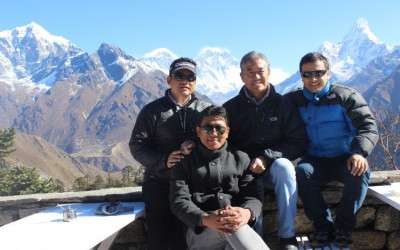- Registered Company
- More than Decade of Experience
- Customer Satisfaction is our motto
Trip Facts
-
Group Size1- 15 pax
-
Max Elevation5106 meters (Larkya La Pass)
-
GradeModerate
-
TransportationJeep and Walk
-
AccommodationTeahouse and Hotel
-
Trip Length13 Days
-
Best MonthSpring and Autumn
-
WIFIAvailable
-
Trip ModeNormal
-
MealAll Meals on Trek
-
Trekking StyleModerate
-
Start FromKathmandu
-
End PointKathmandu
Outline Itinerary
Day 01: Drive from Kathmandu to Machha Khola (930m / 3,051 ft)
Day 02: Trek from Machha Khola to Jagat (1,340m / 4,396 ft)
Day 03: Trek from Jagat to Deng (1,804m / 5,918 ft)
Day 04: Trek from Deng to Namrung (2,630m / 8,628 ft)
Day 05: Trek from Namrung to Lho (2,957m / 9,701 ft)
Day 06: Trek from Lho to Sama Gaun (3,530m / 11,581 ft)
Day 07: Rest Day (Day Trip to Manaslu Base Camp or Pungyen Gompa)
Day 08: Trek from Samagaon to Samdo (3,865m / 12,680 ft)
Day 09: Acclimatization Day: Day Trip to Tibet Border
Day 10: Trek from Samdo to Dharmasala (4,460m / 14,632 ft)
Day 11: Trek from Dharmasala to Bimthang via Larkya La Pass (5,106m / 16,752 ft)
Day 12: Trek from Bimthang to Dharapani (1,970m / 6,463 ft)
Day 13: Drive from Dharapani to Kathmandu (1,300m / 4,265 ft)
Altitude Map
This Altitude Map shows highest alttitude you will trek to each day.
Group Cost
| Group | Cost |
|---|---|
| 3-6 pax | $1200 |
| 1-2 pax | $1300 |
| 7-10 pax | $1200 |
| 11-15 pax | $1100 |
Package Included
- Necessary Local Transport by Private vehicleNational park fees on Treks
- Accommodation on Lodge/Guest House while on treks.
- Meal on full board (breakfast, lunch and dinner) during trekking including Tea/coffee.
- Experienced government license holder trek guide and porter to carry your luggage.
- Insurance of our field staff.
- Trek Permits and Group medical supplies (first aid kit)
- TIMS Card (Trekker’s Information Management System card)
- All additional government tax & Permits.
Package not Includes
- Nepal entry visa fee
- International / any air fare.
- Travelers insurance (compulsory)
- Alcohol/Non Alcoholic Drinks .
- Lunch and dinner/hotel in Kathmandu
- All expenses due to unavoidable events e.g. flight cancellation, personal illness, strike, Political Disturbances etc.
Trip Overview
The Manaslu Circuit Trek is a breathtakingly beautiful and adventurous journey around Mount Manaslu, the world's eighth-highest mountain. This trek leads you through the most inhospitable villages, beautiful forests, and valleys with the majestic views of snow-capped peaks.
Situated in the restricted region of Nepal, it is an ideal choice for those looking for a less crowded and peaceful trekking experience.
The Manaslu Circuit Trek has recently become popular among trekkers due to its unharmed natural beauty and rich cultural experience.
The trek route passes through traditional Tibetan-influenced villages, allowing one to familiarize oneself with the local way of life, monasteries, and ancient traditions.
The Manaslu trekking offers a perfect blend of adventure, nature, and culture while crossing the challenging Larkya La Pass, 5106 m, one of the most beautiful passes in Nepal.
With fewer crowds than Everest or Annapurna regions, it is now seen as an ideal destination for those seeking a quiet, attractive, and authentic trekking experience.
Manaslu Circuit Trek Facts
- Location: In the Manaslu region of Nepal, around Mount Manaslu (8,163m).
- Length: Approximately 177 km (110 miles).
- Duration: Takes 12-14 days.
- Highest Point: Larkya Pass at 5,160 meters (16,930 feet).
- Difficulty: Challenging, with steep ascents and high altitudes.
- Permits: Special permits, including the Manaslu Restricted Area Permit, are required.
- Best Time: Best trekked in spring (March-May) and autumn (Sept-Nov).
- Cultural Experience: It passes through Tibetan Buddhist villages with monasteries.
- Wildlife: Home to snow leopards, Himalayan tahr, and red pandas.
- Accommodation: Basic teahouses along the trail.
Highlights of Manaslu Circuit Trek- 13 Days Itinerary and Cost
- Scenic Views of Mount Manaslu: Breathtaking views of the world's eighth-highest peak (8,163m) throughout the trek.
- Larkya La Pass (5,106 m): A thrilling, scenic, high-altitude pass offering panoramic mountain vistas.
- Rich Tibetan Culture: Explore traditional villages influenced by Tibetan culture, including monasteries and prayer flags.
- Breathtaking Landscapes: Enjoy diverse landscapes, from lush forests and terraced fields to glaciers and rugged terrain.
- Budi Gandaki River Gorge: A trekking route passing through the beautiful Budi Gandaki River with incredible gorges and waterfalls.
- Wild and Secluded Trails: There is less crowding than in the Everest and Annapurna areas.
- Wildlife and Vegetation: Rare animals such as Himalayan Thars, snow leopards, and rhododendron forests.
- Diverse Elevation: Landscape changes and challenges from low to high trekking elevation.
- Local Unspoiled Lifestyle: To witness the local way of life, traditional Gurung and Tibetan villages.
- UNESCO Heritage Sites: Explore ancient Buddhist monasteries and stupas, including the historically significant Pungyen Monastery.
Detail Itinerary
Drive from Kathmandu to Machha Khola (930m / 3,051 ft)
The early morning drive from Kathmandu to Machha Khola, the starting point of the Manaslu Circuit Trek, will be a fantastic adventure in itself as it takes about nine hours of drive through beautiful landscapes, terraced fields, and traditional villages.
First, it follows the Trishuli River, and then it meets the Budhi Gandaki River. While the initial part of the drive is smooth, the final stretch becomes a bit bumpy on rough terrain.
Reaching Machha Khola, a small riverside settlement, you will check into a teahouse for an overnight stay, preparing for the trek the following day.
Breakfast, Lunch and Dinner
Teahouse
930m
Trek from Machha Khola to Jagat (1,340m / 4,396 ft)
The first day of trekking begins with the trail following the Budhi Gandaki River, which has dense forests, small waterfalls, and scattered villages. Gradually gaining height, the trail crosses several suspension bridges over the river and provides beautiful views.
Trekking through the villages of Khorlabesi and Tatopani, also known as a place with natural hot springs, you experience rural living.
You reach Jagat after climbing stone steps and going along rugged paths- a village with a checkpoint for inspecting your permits. This stone-paved village is quite enchanting, so you spend the night here.
Breakfast, Lunch and Dinner
Teahouse
1340m
Trek from Jagat to Deng (1,804m / 5,918 ft)
On the third day, the trail moves steeply uphill. The trails take you through terrace farms and lush forests. This trek presents an immense opportunity to see hills, rivers, and small waterfalls while ascending.
Passing through charming villages like Sirdibas and Philim, you'll notice the strong Tibetan influence in architecture and culture. The trail then narrows down, leading to a suspension bridge into the dense pine and bamboo forests.
After crossing the river a couple of times, you'll arrive at the small village of Deng, which is the entrance to the Manaslu Conservation Area. Overnight stay in Deng.
Breakfast, Lunch and Dinner
Teahouse
1804m
Trek from Deng to Namrung (2,630m / 8,628 ft)
Today's trek begins with a climb that takes you through dense forests, suspension bridges, and rugged trails. The route offers a thrilling panorama of the surrounding peaks and lush greenery.
It winds its way through small villages like Rana and Bihi Phedi, representing the region's rich cultural heritage. The trail continues uphill, and with the gain in altitude, the vegetation changes, and the views of snow-capped mountains start to appear.
Cross various bridges and ascend steeply to reach Namrung, a wonderful village with traditional stone houses and an excellent viewpoint for Manaslu and other peaks nearby.
Overnight stay at Namrung.
Breakfast, Lunch and Dinner
Teahouse
2630m
Trek from Namrung to Lho (2,957m / 9,701 ft)
Today is a relatively short day of trekking with a gradual upward rise. The trail now takes you through forests of rhododendrons and oak, glimpsing the Himalayan peaks as you ascend higher.
You will pass through villages like Sho, where you can get great views of Mount Manaslu and other surrounding peaks. Upon arrival at Lho, a beautiful town, you can visit the famous Ribung Gompa, a beautiful monastery atop a hill.
The village also offers panoramic views of Manaslu, giving a sense of the incredible landscape you are trekking through.
Overnight at a teahouse in Lho.
Breakfast, Lunch and Dinner
Teahouse
2957m
Trek from Lho to Sama Gaun (3,530m / 11,581 ft)
Trekking from Lho to Sama Gaun is relatively short and scenic. Gaining altitude gradually, on the way, you pass forests and fields with the massive Manaslu Himal right in full view.
The trek continues through the village of Shyala, offering spectacular mountain views on every side, such as Himalchuli and Ngadi Chuli. Sama Gaun reflects touches of very strong Tibetan culture with fluttering coloured prayer flags, mani walls, and ancient monasteries.
This village is considered a significant stoppage point for acclimatization. You will rest overnight here in the peaceful landscape with towering mountains.
Breakfast, Lunch and Dinner
Teahouse
3530m
Rest Day (Day Trip to Manaslu Base Camp or Pungyen Gompa)
Today, acclimatization is reserved for adjusting to the high altitude. You can hike to Manaslu Base Camp (4,400m) or visit the Pungyen Gompa, a beautiful monastery.
The hike to Manaslu Base Camp offers stunning views of the Manaslu glacier and the surrounding peaks.
Alternatively, Pungyen Gompa offers serene tranquillity and spirituality amidst great mountain backdrops. This day allows your body to acclimatize to the altitude and take in the beauty of the surroundings. Overnight at Sama Gaun.
Breakfast, Lunch and Dinner
Teahouse
4800m
Trek from Samagaon to Samdo (3,865m / 12,680 ft)
Today's trek is relatively short but essential for gradual acclimatization. Following the yak pastures, the trail gains little elevation but offers excellent views of the surrounding mountains.
You will cross a wide valley and arrive at Samdo, a tiny settlement near the Tibetan border. Samdo is a traditional village where you can observe the Tibetan lifestyle and explore the local culture.
Spend the afternoon resting or exploring the area, preparing for higher elevations ahead.
Overnight stay in Samdo.
Breakfast, Lunch and Dinner
Teahouse
3865m
Acclimatization Day: Day Trip to Tibet Border
Another day of acclimatization in Samdo allows you to hike to the Tibet border. This day's outing will take you up to an altitude of 5,000 meters for stunning views of the surrounding peaks and the Tibetan plateau.
Though challenging, the hike is rewarding as it gives breathtakingly beautiful landscapes and an opportunity to learn about the local trade routes villagers use.
This day helps your body get ready for the strenuous Larkya La Pass.
Overnight stay at Samdo.
Breakfast, Lunch and Dinner
Teahouse
5000m
Trek from Samdo to Dharmasala (4,460m / 14,632 ft)
The trail to Dharmasala starts with a gentle climb that turns steep as you gain altitude. You will pass through dry lands and yak pasture with views of Manaslu and other peaks.
Dharmasala, also known as Larkya Phedi, is a small settlement that forms the base for crossing the Larkya La Pass. The facilities here are basic; accommodation is simple and basic. Having a good night's sleep before the long trek over the pass is a must.
Overnight at Dharmasala.
Breakfast, Lunch and Dinner
Teahouse
4460m
Trek from Dharmasala to Bimthang via Larkya La Pass (5,106m / 16,752 ft)
This is the most challenging yet rewarding day of the trek. You'll start early in the morning to cross the Larkya La Pass. The trail is steep, rocky, and often covered with snow, but the views from the top are breathtaking.
You'll see peaks like Himlung, Cheo Himal, and the majestic Annapurna range from the pass. After crossing the pass, the descent to Bimthang is steep but offers stunning views of glaciers and valleys.
Bimthang is a beautiful village surrounded by mountain peaks where you'll spend the night after a long, adventurous day.
Breakfast, Lunch and Dinner
Teahouse
5106m
Trek from Bimthang to Dharapani (1,970m / 6,463 ft)
The trail from Bimthang descends through lush forests, rivers, and small villages. As the altitude is lost, the climate gets warmer, and the landscape turns to green pastures and farmlands.
You will pass through villages like Tilije and several suspension bridges en route to Dharapani. Here, the Manaslu Circuit trail joins with the Annapurna Circuit Trek.
Overnight at Dharapani.
Breakfast, Lunch and Dinner
Teahouse
1970m
Drive from Dharapani to Kathmandu (1,300m / 4,265 ft)
The final day of the journey involves a long drive back to Kathmandu. During this drive, you go uphill through hills, terraced fields, and nice villages.
After hours of travel, you arrive in Kathmandu again, bustling with activities for rest and to recap your fabulous trekking tour in Manaslu.






















